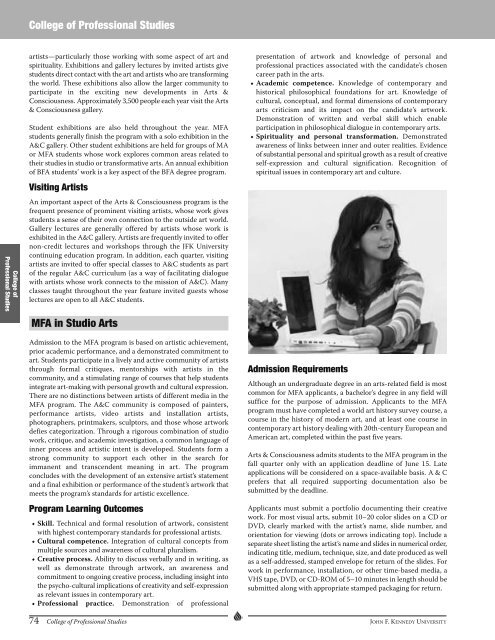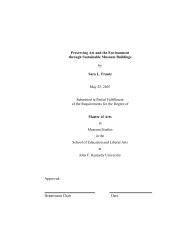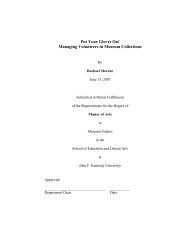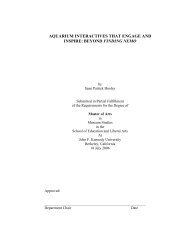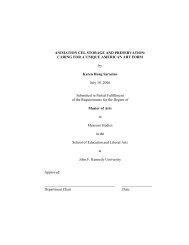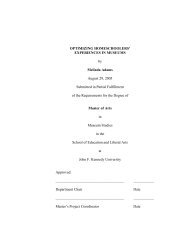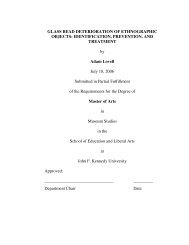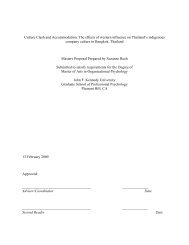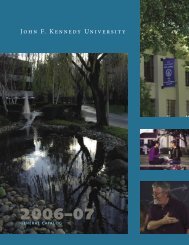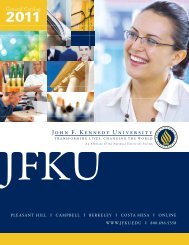Business Administration - John F. Kennedy University
Business Administration - John F. Kennedy University
Business Administration - John F. Kennedy University
Create successful ePaper yourself
Turn your PDF publications into a flip-book with our unique Google optimized e-Paper software.
College of<br />
Professional Studies<br />
College of Professional Studies<br />
artists—particularly those working with some aspect of art and<br />
spirituality. Exhibitions and gallery lectures by invited artists give<br />
students direct contact with the art and artists who are trans forming<br />
the world. These exhibitions also allow the larger community to<br />
participate in the exciting new developments in Arts &<br />
Consciousness. Approximately 3,500 people each year visit the Arts<br />
& Consciousness gallery.<br />
Student exhibitions are also held throughout the year. MFA<br />
students generally finish the program with a solo exhibition in the<br />
A&C gallery. Other student exhibitions are held for groups of MA<br />
or MFA students whose work explores common areas related to<br />
their studies in studio or transformative arts. An annual exhibition<br />
of BFA students’ work is a key aspect of the BFA degree program.<br />
Visiting artists<br />
An important aspect of the Arts & Consciousness program is the<br />
frequent presence of prominent visiting artists, whose work gives<br />
students a sense of their own connection to the outside art world.<br />
Gallery lectures are generally offered by artists whose work is<br />
exhibited in the A&C gallery. Artists are frequently invited to offer<br />
non-credit lectures and workshops through the JFK <strong>University</strong><br />
continuing education program. In addition, each quarter, visiting<br />
artists are invited to offer special classes to A&C students as part<br />
of the regular A&C curriculum (as a way of facilitating dialogue<br />
with artists whose work connects to the mission of A&C). Many<br />
classes taught throughout the year feature invited guests whose<br />
lectures are open to all A&C stu dents.<br />
Mfa in Studio arts<br />
Admission to the MFA program is based on artistic achievement,<br />
prior academic performance, and a demonstrated commitment to<br />
art. Students participate in a lively and active community of artists<br />
through formal critiques, mentorships with artists in the<br />
community, and a stimulating range of courses that help students<br />
integrate art-making with personal growth and cultural expres sion.<br />
There are no distinctions between artists of different media in the<br />
MFA program. The A&C community is composed of painters,<br />
performance artists, video artists and installation artists,<br />
photographers, printmakers, sculptors, and those whose artwork<br />
defies categorization. Through a rigorous combination of studio<br />
work, critique, and academic investigation, a common language of<br />
inner process and artistic intent is developed. Students form a<br />
strong community to support each other in the search for<br />
immanent and transcendent meaning in art. The program<br />
con cludes with the development of an extensive artist’s statement<br />
and a final exhibition or performance of the student’s artwork that<br />
meets the program’s standards for artistic excellence.<br />
Program learning outcomes<br />
• Skill. Technical and formal resolution of artwork, consistent<br />
with highest contemporary standards for professional artists.<br />
• Cultural competence. Integration of cultural concepts from<br />
multiple sources and awareness of cultural pluralism.<br />
• Creative process. Ability to discuss verbally and in writing, as<br />
well as demonstrate through artwork, an awareness and<br />
commitment to ongoing creative process, including insight into<br />
the psycho-cultural implications of creativity and self-expression<br />
as relevant issues in contemporary art.<br />
• Professional practice. demonstration of professional<br />
presenta tion of artwork and knowledge of personal and<br />
pro fessional practices associated with the candidate’s chosen<br />
career path in the arts.<br />
• Academic competence. Knowledge of contemporary and<br />
historical philosophical foundations for art. Knowledge of<br />
cultural, conceptual, and formal dimensions of contemporary<br />
arts criticism and its impact on the candidate’s artwork.<br />
demonstration of written and verbal skill which enable<br />
par ticipation in philosophical dialogue in contemporary arts.<br />
• Spirituality and personal transformation. demonstrated<br />
aware ness of links between inner and outer realities. Evidence<br />
of substantial personal and spiritual growth as a result of creative<br />
self-expression and cultural signification. recognition of<br />
spiritual issues in contemporary art and culture.<br />
admission requirements<br />
Although an undergraduate degree in an arts-related field is most<br />
common for MFA applicants, a bachelor’s degree in any field will<br />
suffice for the purpose of admission. Applicants to the MFA<br />
program must have completed a world art history survey course, a<br />
course in the history of modern art, and at least one course in<br />
contemporary art history dealing with 20th-century European and<br />
American art, completed within the past five years.<br />
Arts & Consciousness admits students to the MFA program in the<br />
fall quarter only with an application dead line of June 15. Late<br />
applications will be considered on a space-available basis. A & C<br />
prefers that all required sup porting documentation also be<br />
submitted by the deadline.<br />
Applicants must submit a portfolio documenting their creative<br />
work. For most visual arts, submit 10–20 color slides on a Cd or<br />
dvd, clearly marked with the artist’s name, slide number, and<br />
orientation for viewing (dots or arrows indicating top). Include a<br />
separate sheet listing the artist’s name and slides in numerical order,<br />
indicating title, medium, technique, size, and date pro duced as well<br />
as a self-addressed, stamped envelope for return of the slides. For<br />
work in performance, installation, or other time-based media, a<br />
vHS tape, dvd, or Cd-rOM of 5–10 minutes in length should be<br />
submitted along with appropriate stamped packaging for return.<br />
74 College of Professional Studies JOHn F. KEnnEdy UnIvErSITy


